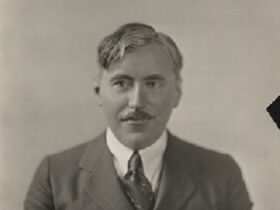Title page from The American Pilgrim’s Way in England to Home and Memorials… by Marcus Bourne Huish. London: Fine Art Society. 1907
Harvest festival observed by the Pilgrims at Plymouth Americans trace the Thanksgiving holiday to a 1621 celebration at the Plymouth Plantation, where the settlers held a harvest feast after a successful growing season. Autumn or early winter feasts continued sporadically in later years, first as an impromptu religious observance and later as a civil tradition. Squanto, a Patuxet Native American who resided with the Wampanoag tribe, taught the Pilgrims how to catch eel and grow corn and served as an interpreter for them. Squanto had learned the English language during his enslavement in England. The Wampanoag leader Massasoit had given food to the colonists during the first winter when supplies brought from England were insufficient.
The Pilgrims celebrated at Plymouth for three days after their first harvest in 1621. The exact time is unknown, but James Baker, the Plimoth Plantation vice president of research, stated in 1996, “The event occurred between Sept. 21 and Nov. 11, 1621, with the most likely time being around Michaelmas (Sept. 29), the traditional time.” Seventeenth-century accounts do not identify this as a Thanksgiving observance, rather it followed the harvest. It included 50 persons who were on the Mayflower (all who remained of the 100 who had landed) and 90 Native Americans. The feast was cooked by the four adult Pilgrim women who survived their first winter in the New World (Eleanor Billington, Elizabeth Hopkins, Mary Brewster, and Susanna White), along with young daughters and male and female servants.
“Pilgrims” are often confused with “Puritans”. Two colonists gave personal accounts of the 1621 feast in Plymouth. The Pilgrims, most of whom were Separatists (English Dissenters), are not to be confused with Puritans, who established their own Massachusetts Bay Colony on the Shawmut Peninsula (current day Boston). Both groups were strict Calvinists, but differed in their views regarding the Church of England. Puritans wished to remain in the Anglican Church and reform it, while the Pilgrims wanted complete separation from the church.
Who were the Pilgrims or the Separatists? The Separatists, or Independents, were English Protestants who occupied the extreme wing of Puritanism. The Separatists were severely critical of the Church of England and wanted to either destroy it or separate from it. Their chief complaint was that too many elements of the Roman Catholic Church had been retained, such as the ecclesiastical courts, clerical vestments, altars and the practice of kneeling. The Separatists were also critical of the lax standards of public behavior, citing widespread drunkenness and the failure of many to keep the Sabbath properly.
Referring to themselves as the Saints, the Separatists believed that they had been elected by God for salvation (see Calvinism) and feared spiritual contamination if they worshiped with those outside of their congregations, often referred to as the Strangers.
In 1608, a community of English separatists decided to escape persecution by moving to Holland, an area long known for its toleration. Dutch society was so welcoming that the Pilgrims, as they had come to be known, eventually feared that they were losing control over their children. In 1620, they set out for a more remote location that would allow them to protect their community. This effort resulted in the founding of Plymouth Colony.
Huish’s book The American Pilgrim’s Way…traces the origins of the Pilgrim or Separatist founders of the Plimoth Plantation including Captain Miles Standish, John Winthrop, and Thomas Dudley, from their homelands in England (see below) to the shores of modern day Massachusetts.
This volume is an exquisitely decorated art book that contains lavish black and red wood block prints, vintage black and white photographs of English manors, watercolor illustrations of church yards and landscapes, along with facsimiles of historical family specific documents, certificates, and memorials.
If you would like to see this rare book, either to study its art work or read up on your favorite Pilgrim, it is housed in the Special Collections and University Archives department located on the second floor of the Bartle Library. The department is open from 10:00 am to 4:00 pm, Monday – Friday.
The American pilgrim’s way in England to homes and memorials of the founders of Virginia, the New England States, and Pennsylvania, the Universities of Harvard and Yale, the First President of the United States & other illustrious Americans by Marcus B. Huish; illustrated by Elizabeth M. Chettle. London: Fine Art Society. 1907.
Call Number: **E 188. H9 1907. Rare Book Collection, Double Oversized.
This issue is limited to five hundred copies of which the University Libraries owns No. 1.




